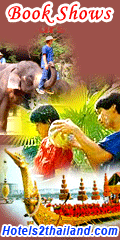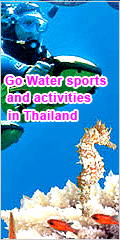
THE SOUTH
This region extends southward along a narrow peninsula lying between the Andaman Sea its west side and the South China Sea on the east. It is a rich land in terms of the abundance of its natural resources, the fertility of its soil, the diversity of its people and its commercial viability.
The South is made up of 14 provinces from Chumphon in the north down to the Malaysian border 1,200 kilometres from Bangkok. It has a long coastline on either side with sandy beaches and offshore islands on both, and a rugged central hinterland of mountains and forests.
The east coast on the Gulf of Thailand always seems to be more relaxed, with long, wide bays and calm seas; the Andaman Sea coast tends to be more rugged and exhilarating, with its strange limestone rock formations and cliffs.
 The occurrence of two seasonal monsoons means that the climate differs from the rest of Thailand. The southwest monsoon sweeps the west coast and the Andaman Sea from May to October, while the northeast monsoon moves across the Gulf of Thailand form November to February. The peninsula forms a barrier so that rain rarely falls on both coastlines simultaneously.
The occurrence of two seasonal monsoons means that the climate differs from the rest of Thailand. The southwest monsoon sweeps the west coast and the Andaman Sea from May to October, while the northeast monsoon moves across the Gulf of Thailand form November to February. The peninsula forms a barrier so that rain rarely falls on both coastlines simultaneously.The area was once part of the Buddhist Srivijaya Empire but later came under the rule of Ayutthaya and then Bangkok. Chinese and Malaysian influences have played a large part in the cultural makeup of the region; the further south, the stronger the Malaysian influence, with a dialect akin to Malay, a predominance of Muslim communities and mosques. Rice fields give way to rubber plantations, and Chinese tin mining operations become evidence.
The coastline attracts most tourists, though Samui island in the Gulf of Thailand is growing in popularity as a laid-back holiday spot with first class diving opportunities nearby on Tao and Pha-ngan islands.
The Andaman Sea coast offers more sophisticated choices in the island province of Phuket, Thailand’s premier holiday resort. However, the fascinating rock formations and offshore islands at Phang-nga, Krabi and Trang are extremely popular for the diving and sailing opportunities they offer.
The mountains, rivers and forests in the national parks in the interior of the peninsula are also gaining popularity with eco-tourists, as can be seen with the growing numbers of safari expeditions on foot, by elephant and in canoes.
The South of Thailand consists of 14 provinces: Chumphon, Krabi, Nakhon Si Thammarat, Narathiwat, Pattani, Phang-nga, Phatthalung, Phuket, Ranong, Satun, Songkhla, Surat Thani, Trang and Yala.
Credit to: http://www.tourismthailand.org
























